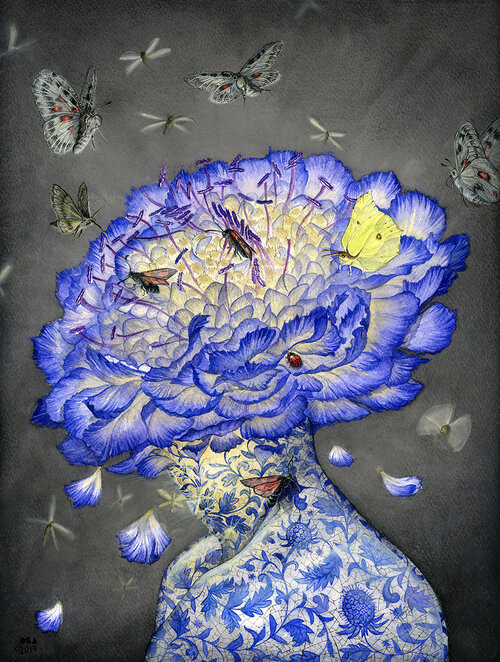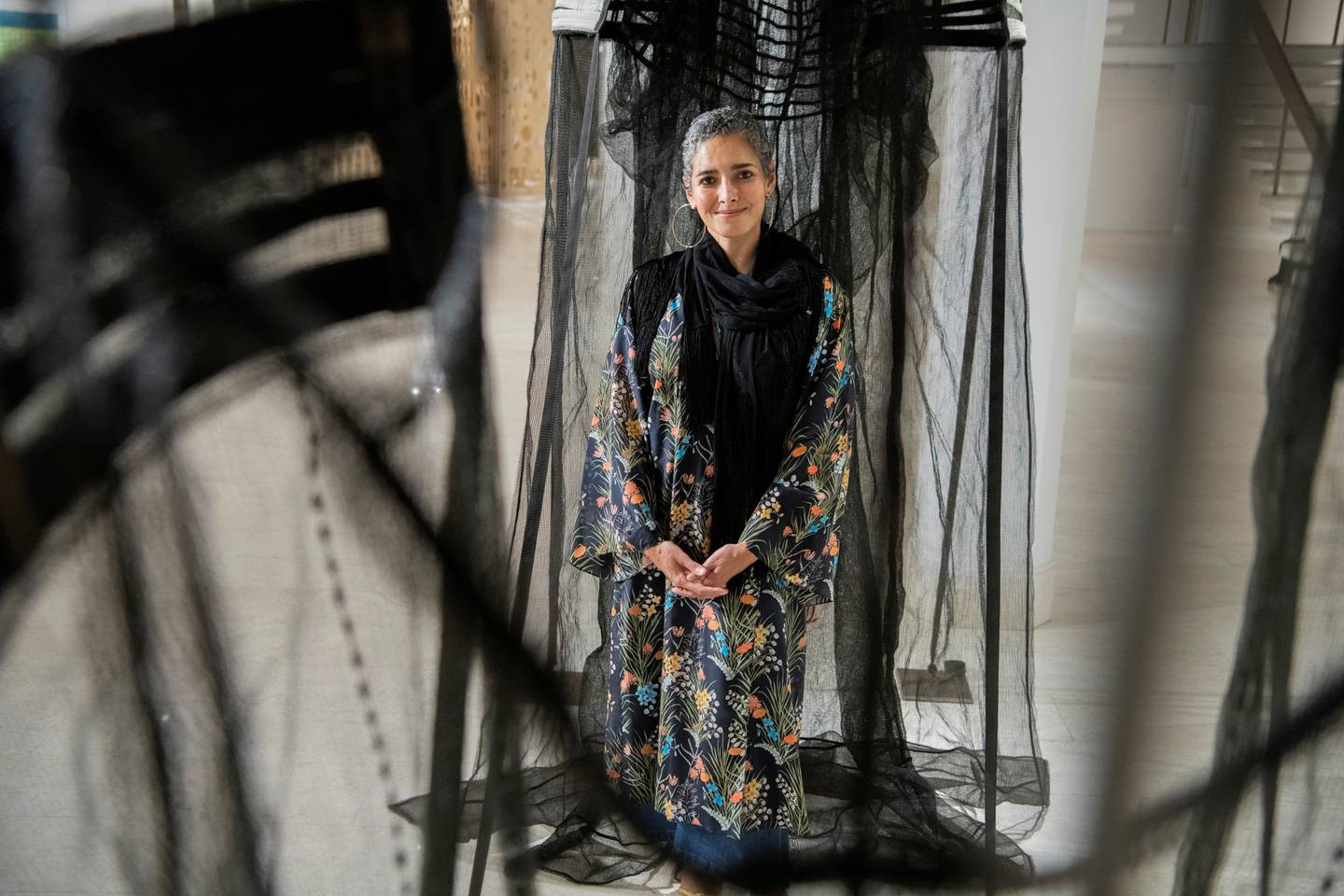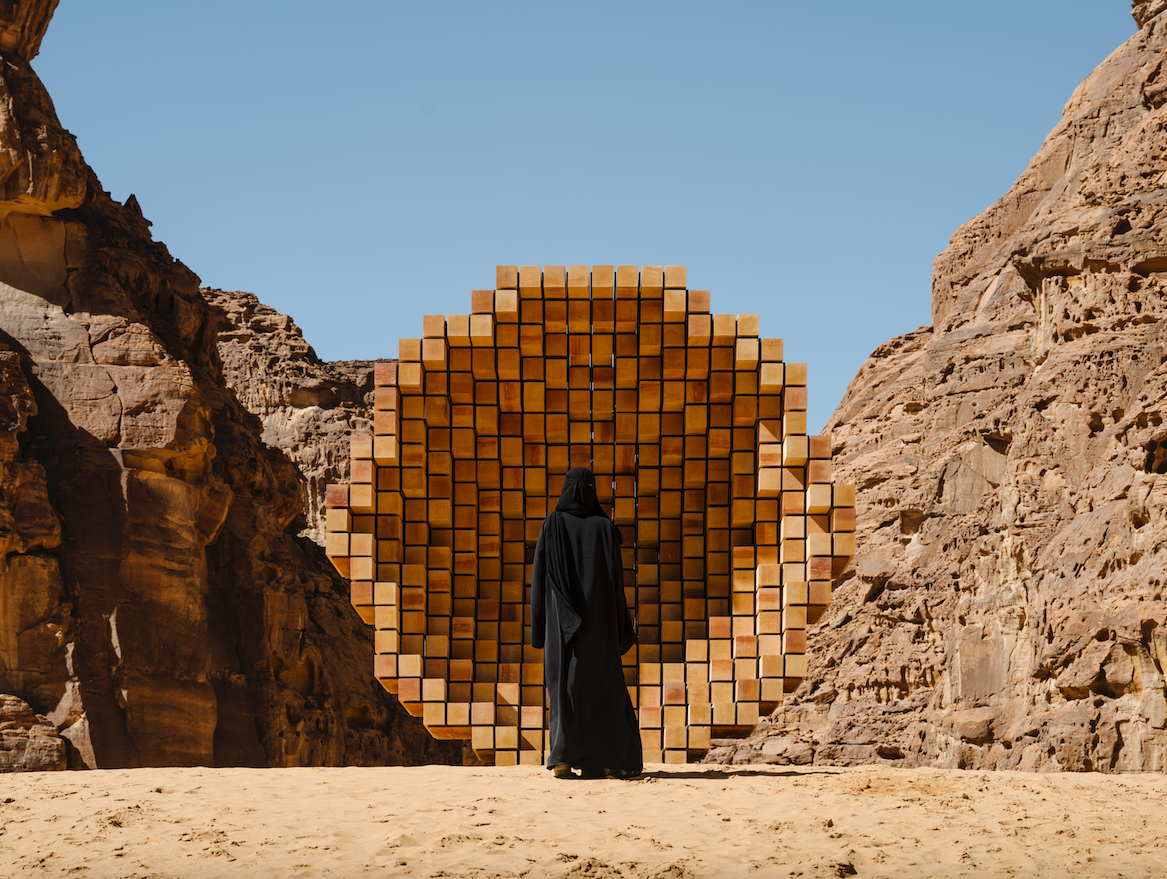Four Artists Challenging the Status Quo in Saudi Arabia
01 Apr 2022As a student at an all-boys high school in Jeddah, multidisciplinary visual artist Obadah Aljefri redesigned his traditional Arabic thobe school uniforms by adding original accents like polo shirt collars, zippers and even transforming one into a “hoodie”. “I was always the creative child who did not fit the bill of what a boy was supposed to look, dress, talk or walk like and I faced many challenges – so guess I was always pushing the envelopes,” he smiles. He seems very at ease wearing a lavender blazer over a tee shirt, his curly hair pulled into a top knot. You cannot help but notice him standing near his kaleidoscopic work at the opening of 21’39 exhibition in Jeddah, where the theme of Amakin (meaning home), inspired him to create a supersized version of his childhood sketchbook; a place where he could express himself with complete freedom.
Obadah’s work is rooted in identity struggles amidst the newfound openness that Saudi is easing into. “When I graduated from high school there was no art school, majors or degrees for men here, so I convinced my family to let me study in the States”. As a student at SCAD, he was hungry for technical skills that could feed his passions but also realistically provide a skill to earn a living; hence his proficiency in animation and illustration which clearly spill over into his work. His bright, humorous and often sarcastic style has landed him both features with international brands like Scotch and Soda and grants from nonprofit organizations. “I still order most of my materials from abroad because there are not a lot of suppliers for professional grade materials and tools in Saudi,” he explains. “I do believe there is a lack of comprehension for the difficulties that Saudi-based artists face.” The Chapman Brothers, Ai Wei Wei and Patricia Paccinini are a few of the artists Obadah feels particularly inspired by. “We live in a very depressing time and humor is a great way to communicate with the viewer without overwhelming them.”
“Most artists are sensitive and in tune socially, environmentally, politically and culturally, so whether the art they make is in direct or indirect reaction to these issues; it will be reflective of the times and places they live in”, says conceptual artist Filwa Nazer, who spent her childhood in Jeddah before moving to Milan, where she was formally trained as a fashion designer. Her large-scale works are highly influenced by these roots. Her portraits and sculptures made of fabrics, some diaphanous and others opaque, are perhaps impeccable metaphors for the female experience in Saudi Arabia. “Being a woman in Saudi today stands in stark contrast to what it was at the time I was growing up, which was very conservative and restrictive, she explained on a balmy evening in Jeddah following a personal tour of Saudi Modern where she was one of the featured artists. After a decade in London defining her artistic career, Nazer recently relocated back to Jeddah. “There have been several civil and labor laws amendments concerning women, notably the ending of the male guardianship law which allowed women to be independent and to confidently be part of the workforce. There has been a shift as well socially and culturally with the recent changes.” She explains how living through the oil boom and the religious conservatism generation has influenced her evolution as an artist. While some of her earliest works blurred faces, her current works are less about censorship and more about empowerment. Constructed from repurposed garment patterns and textiles, these sculptures commemorate stories and memories of Saudi women and address ideas of vulnerability in times of transformation.
Saudi-Palestinian artist Dana Awartani uses craft traditions to preserve the past while simultaneously stretching to touch the future. Sand, soil and other local natural elements are her tools. “I started out using sand because it is everywhere and readily available. People ask me if it is sad to work on an installation that is eventually destroyed, but for me it demonstrates the nostalgia that can be so easily lost.” Where The Dwellers Lay, a breathtaking 17-ton geometrical sculpture installed for Desert X amongst the shapely AlUla rocks once home to Nabataen civilizations has international commissions nipping at her heels. But en route to meetings in California, Awartani explained it is the process, not the profits that have profoundly inspired her works. “My goal is to be able to continue doing what I am doing and inspire the younger generation in Saudi Arabia: it is possible to have a career as an artist which was never really a reality in the past.”
Performance artist Sarah Brahim also never imagined being celebrated in her hometown of Riyadh at the city's first biennale. Relocating to the United States at a young age during the Gulf War and living between the two cultures has tremendously impacted the messaging in her performance art. Dancers projected on six and a half foot screens and clad in white body-skimming costumes undulate close but never touch in her installation Soft Machines/Far Away Engines at the Diriyah Biennale. “It's about distance between us even if we are so close,” she explains, “we exist far apart from each other, but we make connection despite the distance.” For her 2021 performance Our Cup is Broken, originally to be performed in London before COVID-19 made human connection even less plausible, Brahim crossed both physical and geographical borders performing live from her Riyadh studio while her video mapping partner managed the projections from the United States. “We could have recorded, but I felt it was important to be live in the breath of those moments.” Brahim studied medicine in between dance and is captivated with the landscape of the human body. “I think of the body as architecture and engaging in the cultural context to bring more empowerment to people in their bodies. I hope my work exists to build connection and paint the future.”
– words by Dorian May




